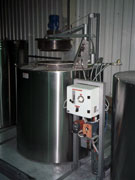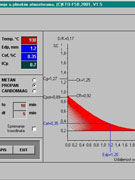Carburizing
Controlled gas atmospheres
Carburizing in large furnaces are performed in controlled gas atmospheres using different types of gases (endo-gas, methane, propane, acetylene), but in the small furnace system cost effective synthetic gas atmosphere based on methanol (CH3OH) and nitrogen (N2). Adding ethyl acetate or propane increases the carbon potential and in the second stage of carburizing introduced air reduces the carbon potential. This gas atmosphere is applied over 750 °C, usually between 800 and 950 °C. At the exit of the retort gas atmosphere ignites on the torch. Control of carbon potential is carried out applying different types of sensors, most recently using the Lambda sensor with program controllers using dedicated software. Some specific types of furnaces are used for gas carburizing depending on form and dimension of treated parts.
Pit type furnace for carburizing in controlled gas atmosphere
Gassing: Methanol, Ethyl Acetate, Nitrogen, Air.
Carbon potential control: Lambda Sensor
Process control: Program Controller



